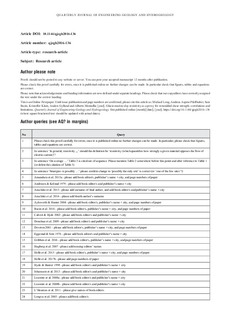| dc.contributor.author | Long, Michael | |
| dc.contributor.author | Pfaffhuber, Andreas Aspmo | |
| dc.contributor.author | Bazin, Sara | |
| dc.contributor.author | Kåsin, Kristoffer | |
| dc.contributor.author | Gylland, Anders Samstad | |
| dc.contributor.author | Montaflia, Alberto | |
| dc.date.accessioned | 2018-02-13T12:09:45Z | |
| dc.date.available | 2018-02-13T12:09:45Z | |
| dc.date.created | 2017-12-06T14:40:09Z | |
| dc.date.issued | 2017 | |
| dc.identifier.citation | Quarterly journal of engineering geology and hydrogeology. 2017, . | nb_NO |
| dc.identifier.issn | 1470-9236 | |
| dc.identifier.uri | http://hdl.handle.net/11250/2484369 | |
| dc.description.abstract | In geotechnical engineering in Norway, Sweden and Canada the presence of sensitive and/or quick clays poses a major challenge. Formation of these clays involves the leaching of salt from the pore fluid. Thus it has been recognized that electrical resistivity measurements could be useful in delineating leached and unleached clays. This paper seeks to assess the applicability, repeatability and reliability of the various geophysical techniques in the study of sensitive clays. It also attempts to understand the factors that control the measured resistivity and in particular to determine the limitations of directly obtaining the remoulded shear strength from the resistivity measurements. It was found that borehole, surface and airborne resistivity measurements are accurate and compatible. For the 30 Norwegian sites studied it was found that resistivity is primarily defined by the porewater salt content, with minor additional influence by clay content and plasticity, and porosity. A relationship exists between resistivity and remoulded shear strength but this is limited to material deeper than the dry crust and a surface weathering zone of about 7.5 m thickness. High resistivity (>10 Ω m) may indicate quick or weathered clay but low resistivity (<10 Ω m) conclusively points to stable, unleached clay. | |
| dc.language.iso | eng | nb_NO |
| dc.title | Glacio-marine clay resistivity as a proxy for remoulded shear strength: correlations and limitations | nb_NO |
| dc.type | Journal article | nb_NO |
| dc.type | Peer reviewed | nb_NO |
| dc.description.version | acceptedVersion | |
| dc.source.pagenumber | 16 | nb_NO |
| dc.source.journal | Quarterly journal of engineering geology and hydrogeology | nb_NO |
| dc.identifier.doi | 10.1144/qjegh2016-136 | |
| dc.identifier.cristin | 1523659 | |
| cristin.unitcode | 7452,3,2,0 | |
| cristin.unitcode | 7452,2,2,0 | |
| cristin.unitname | Geokartlegging | |
| cristin.unitname | Feltundersøkelser | |
| cristin.ispublished | true | |
| cristin.fulltext | postprint | |
| cristin.qualitycode | 1 | |
